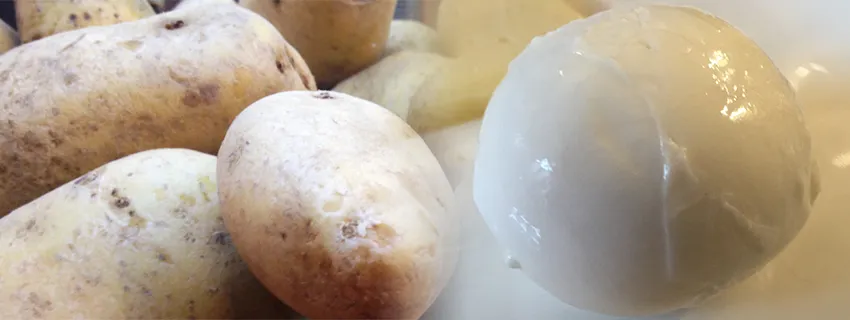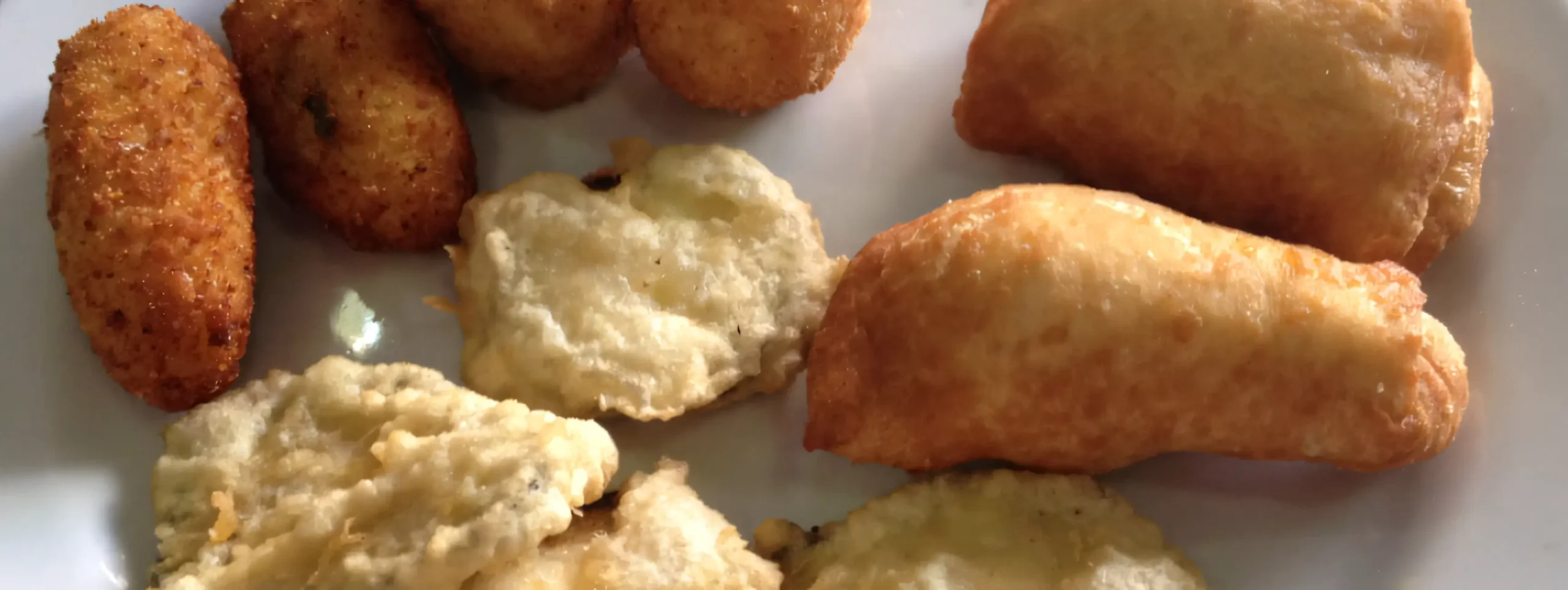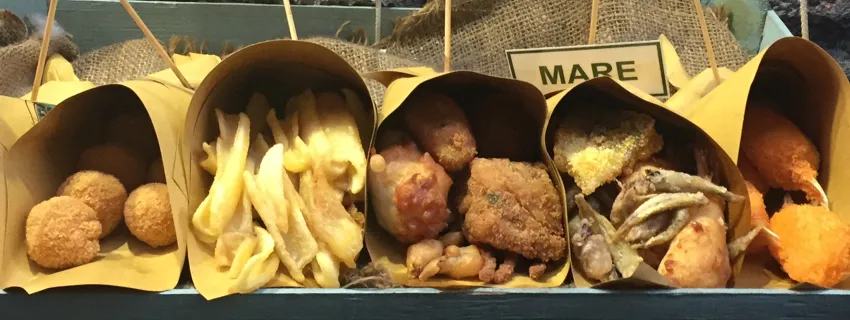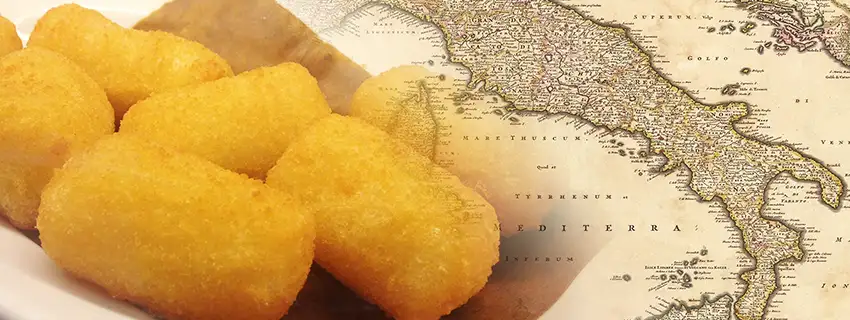Published:
Author: Antonio Maria Guerra
Crocchè
The Neapolitan Potato Croquette

Although potato croquettes are a specialty appreciated in many countries around the world, the Neapolitan variant, the ‘Crocchè’, has a very peculiar taste, closely linked to the character of the city. Let’s find out what makes this delicacy so unique: to do so, let’s savor it while strolling through the narrow alleys of Naples’ historical center, the ‘vicoli’.

What are Neapolitan Crocchè?
‘Crocchè’ is one of the most typical street foods in the Neapolitan culinary tradition. It’s basically a potato croquette, enriched with parsley and pepper. Its crispy surface, characterized by an inviting golden color, encloses a soft filling.

Le friggiorie napoletane più tradizionali.
Here follows a brief list of some of the most traditional fried food shops (‘friggitorie’) in Naples: fascinating places, where you can enjoy the original taste of Neapolitan Crocchè.
Read more
- Friggitoria Fiorenzano
Via Pignasecca, 48, 80134 Naples (Italy); - Friggitoria Vomero
Via Domenico Cimarosa, 44, 80129 Naples (Italy); - Rosticceria Imperatore
Viale Colli Aminei, 66, 80131 Naples (Italy);

The origins of Neapolitan potato Crocchè.
The origins of the Neapolitan potato Crocchè are far from certain. In this regard, it should be noted that similar specialties are part of the gastronomic tradition of many countries. Currently, the most reliable theories associate this delicacy with two nations in particular: France and Spain. This is no coincidence, considering that their domination over the city of Naples and, more generally, over the south of Italy (*1), was quite important, also from the point of view of food.
French origins:
According to this theory, which is also the most popular, the Neapolitan Crocchè could be an evolution of the French ‘Croquettes’. It’s in fact quite possible that their recipe was introduced in the city during the second half of the 1700s by the French chefs who cooked for Ferdinand I of Bourbon (*2) and his wife Maria Carolina of Austria.
Spanish origins:
The second hypothesis, considered by many to be the least possible, suggests that the Neapolitan Crocchè might be an evolution of the Iberian ‘croquetas’.

Notes:
*1: Reason why preparations very similar to Crocchè, such as the Sicilian ‘cazzilli’, can be found in many places in southern Italy.
*2: Ferdinand I of the Two Sicilies, formerly Ferdinand III of Sicily and Ferdinand IV King of Naples. He was nicknamed ‘Re Nasone’ (big-nose king), because of the size of his nose (as proved by many portraits of the time), and ‘Re Lazzarone’ (‘Lazy King’), because he loved to mingle with his people (in incognito, of course).
Naples: the birthplace of Crocchè.
Naples, the birthplace of Crocchè, is a city rich in history, culture, and tradition. Overlooking the gulf bearing the same name, this place offers tourists, in addition to a breathtaking landscape, a unique atmosphere in which past and present blend together. It is by walking through the alleys (the ‘vicoli’) of its historic center that one can really get close to its heart, in a journey that involves all the senses, including that of taste.


How are Neapolitan potato Crocchè made? (hints)
Neapolitan crocchè are quite simple, made with just a few ingredients. The real secret of success when making them is the care that must be taken in their preparation. Here is a brief list of these steps:
Boil the potatoes, including their skin;
Once cooked, peel the potatoes;
Mash the potatoes;
Add salt, pepper, and parsley to the mashed potatoes (some people also add Pecorino and/or Parmigiano cheese);
Using the mashed potatoes, shape them into small, irregular cylinders;
Bread these cylinders using eggs and breadcrumbs;
Dip the small cylinders in boiling oil until they reach a dark golden color;

Crocchè, the neapolitan potato croquette: ingredients.
The ingredients used to make the neapolitan potato croquettes are:
- Potatoes;
- Eggs;
- Parsley;
- Salt;
- Pepper;

The differences between ‘Crocchè’ and ‘Panzerotto’.
The Neapolitan potato Crocchè has, so to speak, a ‘big brother’: its name is ‘Panzerotto’ (or ‘Panzarotto’). Granted that the two delicacies are very similar, it’s important to remember that the Panzerotto differs from the Crocchè mainly for the (bigger) size and the presence of a filling consisting of mozzarella cheese. Let’s examine the two specialties in detail:

The Crocchè:
The Crocchè is generally small, no longer than 3 to 4 centimeters. Its dark gold breading looks inviting and covers a soft inner part made of potatoes, eggs, breadcrumbs, parsley, and black pepper.

The Panzerotto:
The panzerotto is larger than a crocchè: about 7/8 inches. Its breading, of a light golden color, covers a soft filling made of potatoes, parsley, and black pepper, enriched with smoked provolone cheese and/or mozzarella.


Crocchè: calories and nutritional values.
One hundred grams (0,22 lb) of Neapolitan potato Crocchè (about 4/5 pieces) contains, roughly, from 180 to 190 calories.
The specialty has carbohydrates, fat, protein, fiber and sodium.

Vicoli: the ‘secret ingredient’ of the Neapolitan potato croquettes.
The Neapolitan Crocchè is nothing more than one of the many variants of the classic potato croquette, a kind of street food much popular in many countries. It’s legitimate to ask how they differ from the ‘competition’: the answer to this question may surprise you. What makes them special, the ‘secret ingredient’ that can give them a truly unique flavor, is the place where, generally, they are eaten, even better if this is done while walking. we are speaking about the ‘Vicoli’, the narrow alleys of the Neapolitan historical center: special locations, full of such charm that they infuse some of it into the food. Let’s try to understand what they really are.
The word ‘vicolo’ comes from the Latin ‘viculus’, indicating a very narrow alley. Even today it’s easy to find them in the historic centers of many Italian cities.
The Neapolitan vicoli are, without doubt, among the most colorful and characteristic: many date back to the period of Spanish rule, which lasted from the 16th to the 18th century. It’s therefore no coincidence that the area in which the greatest number of them can be found still bears the name ‘Spanish Quarters’ (‘Quartieri Spagnoli’). Although very small, for hundreds of years these streets have housed both the dwellings of the poorest people, the so-called ‘Bassi’, and the most diverse commercial activities: every day thousands of people spend their lives within these strange roadways that, despite everything, ensure viability.
Walking down a Vicolo allows feeling sensations that should be absolutely tried: one is overwhelmed by a mix of sounds, colors, smells, and tastes. All the senses are involved in an experience that transcends the sum of the parts.


A ‘cuoppo’ for the Neapolitan potato crocchè.
In Naples, the ‘cuoppo’ (in dialect, ‘cuopp’), a cone made from sheets of straw paper, is used for savouring fried food while while strolling through the city.

Potato croquettes in Italy.
Neapolitan potato croquettes are just one of the many variants of the potato croquette that can be tasted in Italy. Among the most famous of them, it’s important to mention:
- The Sicilian ‘Cazzilli’;
- The Calabrian ‘Pitticelle’;
- The Piedmontese ‘Subric’ (disc-shaped);

Friggitorie: heirs to a distant past.
Neapolitan crocchè can be purchased in one of the many ‘friggitorie’ that dot the city. These are shops specialized, as is easy to understand from the name, in the preparation and sale of fried food. Their wares consist of small delicacies combining taste and simplicity, all characterized by great portability.
It’s difficult not to notice the close resemblance between these commercial establishments and modern fast-food restaurants.
After all, this type of enterprise has existed since the remotest past: the famous archaeological sites of Pompeii and Herculaneum bear witness. Despite the passage of centuries, both are almost intact still today, spared from the corruption of time ‘thanks’ to the eruption of Vesuvius, the famous volcano. Walking along their streets it’s possible to come across the ‘couponae’: small stores that long ago served food and drink to passers-by. These picturesque places should be considered the ancestors of today’s friggitorie.
Nowadays, friggitorie can be found in many Italian cities: the oldest and most renowned are, in addition to Naples, Genoa, and Palermo.

The right drink for crocchè the neapolitan potato croquette.
Although crocchè in Naples is often accompanied by a Lager beer, a very valid alternative might be a glass of red wine, fairly tannic, fairly smooth, and fairly acid.
- The tannicity balances the greasiness of the fried food;
- The alcohol content balances the saltiness;
- The acidity balances the sweet tendency of the potato;
Copyright information.
The images displayed in this page belong to WebFoodCulture, with the exception of:
Creative Commons Images
- “Croquetas” by PincasPhoto licence CC BY 2.0.










